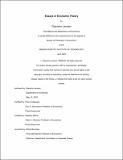| dc.description.abstract | The first chapter of this thesis considers an agent who posits a set of probabilistic models for the payoff-relevant outcomes. The agent has a prior over this set but fears the actual model is omitted and hedges against this possibility. The concern for misspecification is endogenous: If a model explains the previous observations well, the concern attenuates. We show that different static preferences under uncertainty (subjective expected utility, maxmin, robust control) arise in the long run, depending on how quickly the agent becomes unsatisfied with unexplained evidence and whether they are misspecified. The misspecification concern’s endogeneity naturally induces behavior cycles, and we characterize the limit action frequency. This model is consistent with the empirical evidence on monetary policy cycles and choices in the face of complex tax schedules. Finally, we axiomatize in terms of observable choices this decision criterion and how quickly the agent adjusts their misspecification concern.
The second chapter offers an axiomatization of risk models where the choices of the decision maker are correlation sensitive. By extending the techniques of conjoint measurement to the nondeterministic case, we show that transitivity is the vN-M axiom that has to be relaxed to allow for these richer patterns of behavior. To illustrate the advantages of our modeling choice, we provide a simple axiomatization for the salience theory model within our general framework. This approach leads to a clear comparison to popular preexisting models, such as regret and reference dependence, and lets us single out the ordering property as the feature that brings salience theory outside the prospect theory realm. This chapter is published in the Quarterly Journal of Economics, vol 137.
The third chapter proposes a model of non-Bayesian social learning in networks that accounts for heuristics and biases in opinion aggregation. The updating rules are represented by nonlinear opinion aggregators from which we extract two extreme networks capturing strong and weak links. We provide graph-theoretic conditions on these networks that characterize opinions’ convergence, consensus formation, and efficient or biased information aggregation. Under these updating rules, agents may ignore some of their neighbors’ opinions, reducing the number of effective connections and inducing long-run disagreement for finite populations. For the wisdom of the crowd in large populations, we highlight a trade-off between how connected the society is and the nonlinearity of the opinion aggregator. Our framework bridges several models and phenomena in the non-Bayesian social learning literature, thereby providing a unifying approach to the field. This chapter is the result of joint work with Simone Cerreia-Vioglio and Roberto Corrao.
JEL codes: D9 | |
